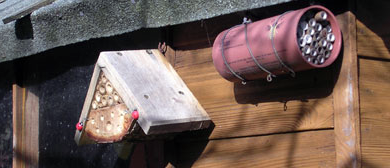Making a Bug Home
This is definitely interesting to observe bugs behavior in natural area of habitat. However, you can help both yourself and a bug by making a bug-home to place in your garden. The insects will be happy to settle there and you will have a chance to observe them closely.
Making a worm-house

This little wormery is very easy to make and excellently suits to observe the life of worms.
Find two plastic bottles one of which will be little bigger than the other one (both bottles should be rather large). You will also need some sand and some peat-free compost (you can buy get those at any garden center). In the bottom of the large bottle make some small holes so that the surplus of water will drip out through them. Cut off the top of the large bottle and insert a small bottle filled with cold water into it. The purpose of the smaller bottle is to keep worms cool.
Fill the space left between the two bottles with alternating layers of sand and compost. Then moisture these layers with rainwater. When the new wormhouse is ready, find a couple of worms by digging them out in you own garden and place them in the bottle. It’s now time to observe. The worms should dig through the layers and you will see these paths. You may also see their burrows as well. Just don’t forget to keep worms in a cool and dark place.
Making a bee-house
Mason bee box is quite easy to make as well. You’ll need some hollow twigs (bamboo or buddleia stems are perfect for that purpose), large old coffee tin or a flower pot, modeling clay, a garden wire and insulation tape. Make sure your container is steady and wash it. Then attach the string or wire to it. It should go around the tin and the open end of it should slope down just a little bit when it gets hung up. If you think that wire placed around does not hold it well enough you can make several holes in container and thread the wire through them.

Put some modeling clay at the bottom of container and stick hollow wooden poles into it. Remember to cut the poles little shorter than the size of the container. Place as many wooden poles as it takes to fill the container completely.
Now it’s time to hang your bee box. It’s important to choose the right place for it. It should be dry and sunny place. The entrance should face the south for more light to come in and heat the bee home. Don’t forget to slope the container little bit downward so that the bees do not get wet when it rains.









